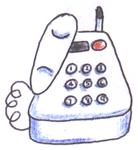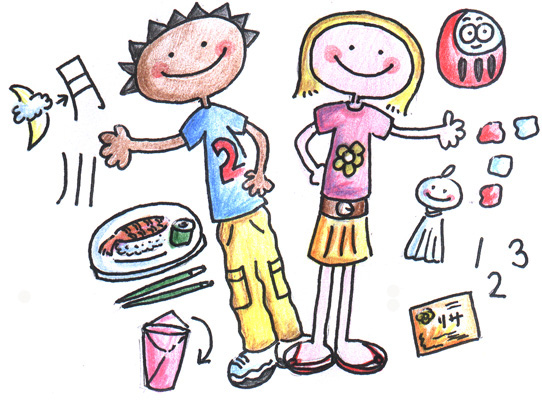Lesson 2
Lesson Plan Download pdf
Starter (15-20 minutes)
Refresh the numbers 1 – 10 by counting in different styles (quickly, slowly, in reverse order etc).
Does anyone know what 11 might be? (You may find that some children will say ichi ichi - いちいち or ‘one, one’) If so, prompt them with the following: How many ‘tens’ have you got in the tens column? How many units? So 10 + 1 = 11. What is 10 in Japanese? (ju - じゅう). What is 1? (ichi - いち) so 11 is read as juichi じゅういち - use the number presentation to reinforce this.
If you know that 11 is juichi, then what do you think 12 is? (juni じゅうに) Can you count all the way up to 19?
What about 20? Look at how many tens you have. You have 2 tens, so twenty is read as niju にじゅう or ‘two lots of 10’. Can you count all the way up to 99 now?
Optional Extras:
Hand out pairs of dice to pairs of children. They throw the dice and do
various activities – can they multiply the numbers together, add them
together, multiply the numbers and then halve the result, add the 2
numbers of the dice together and calculate what needs to be added to
make 20, 50, 100 etc? Another option would be to throw one or two dice
and have the children try to calculate the numbers on the underside using
inference and deduction.
Learn telephone numbers. You could read out a number and children have to scribe it, or have a child come up to the front and say their phone number in Japanese.
As a further extension you could use ‘real’ Japanese phone numbers and teach them some of the area codes. Where there is a gap between the area and local code, Japanese people tend to say ‘no - の’. This helps to break the number up:
Examples:

| Tokyo: 03 | Osaka: 066 |
| Yokohama: 045 | Kyoto: 075 |
| Sapporo: 011 | Kobe: 078 |
| 03 275-6142 | |
| zero san no ni nana go no roku ichi yon ni (desu) | |
| 03 275-6142 です | |
(You could ask children to confirm which city it is they are calling and have them identify it on a Japan map.)
Use the ‘how much?’ presentation to show the cost of various items and have children answer with the cost of the products using the numbers they’ve learnt. Explain first of all that the Japanese currency is the yen, but when said in Japanese, is ‘en’.
Model the following conversation with the Japanese teacher. Alternatively, use the dialogue soundfile to demonstrate:
| A: | いくらですか | ikura desu ka | How much is it? |
| B: | 98 円です | kyujuhachi en desu It’s 98 yen |
Show the children pictures of Japanese money in the ‘how much’ presentation and discuss the images on the notes and the shapes of the coins. Note that the 10,000 yen note is pronounced as ‘ichi man en - 一万円’ Literally, ‘one lot of ten-thousand’ yen in English.
